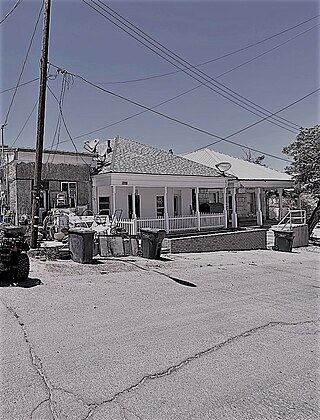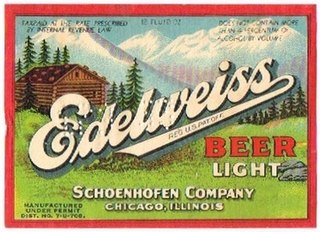
The Mizpah Hotel is a historic hotel in Tonopah, Nevada, U.S. It is a member of Historic Hotels of America, the official program of the National Trust for Historic Preservation.

Oliver Green Traphagen was an American architect who designed many notable buildings in Duluth, Minnesota, during the late 19th century and in the Territory of Hawaii during the early 20th century. Among his most famous landmarks are the Oliver G. Traphagen House in Duluth, called the Redstone, and the Moana Hotel in Honolulu, both of which are on the National Register of Historic Places, as are several other buildings he designed.

The Nye County Courthouse in Tonopah, Nevada is a two-story rusticated stone building. Its Romanesque Revival entrance and pointed dome are unique in Nevada. The courthouse was built following the move of the Nye County seat from Belmont to Tonopah in 1905.

The Central Fire Station is located in downtown Davenport, Iowa, United States and serves as the headquarters of the Davenport Fire Department, as well as the downtown fire station. Built from 1901 to 1902, the original building is the oldest active fire station west of the Mississippi River. It was individually listed on the National Register of Historic Places in 1982. In 2020 it was included as a contributing property in the Davenport Downtown Commercial Historic District.

The Bass Building is a historic building located at 119 St. Patrick in Tonopah, Nevada. Built in 1904, the building is the third oldest stone commercial building in Tonopah. The building has a simple stone design reflective of a transitional period between rustic and well-crafted stone buildings. A. A. Bass built the structure as a lodging house; it later served as offices for a telephone company and as a fraternal lodge. A 1912 fire gutted the building's interior, but Bass rebuilt it the following year.

The Tonopah Liquor Company Building is a historic building located on Main St. in Tonopah, Nevada. The building was constructed in 1906 by the Tonopah Liquor Company. The stone building was designed in the Classical Revival style and features a large pediment with a stone cornice. While the building was one of many stone structures built in Tonopah's early history, it is now one of only four remaining in the town; a local historic survey claimed it to be the most well-crafted of the remaining buildings.

The Water Company of Tonopah Building is a historic building located at the intersection of Burrough and Brougher Avenues in Tonopah, Nevada. Built in 1909, the building housed offices for the Water Company of Tonopah. Tonopah's first water service began in 1902, when three water companies each gained franchises to provide water to one district of the town. By 1905, Philadelphia businessman John Brock owned two of the water companies, which he consolidated into the Water Company of Tonopah. Brock also owned multiple mines in Tonopah and the local railroad. The Water Company of Tonopah Building is the only surviving building which belonged to one of Tonopah's early water companies.
The Tonopah Mining Company Cottage is a historic house located on Queen Street in Tonopah, Nevada. Built in 1902, the home is one of the oldest frame houses in Tonopah. The house was constructed by the Tonopah Mining Company, the largest silver mining company in Tonopah. The cottage was the second home built for the company's employees and the oldest of the three surviving company houses built by the company.

The Tonopah Volunteer Firehouse and Gymnasium is a historic fire station located at the intersection of Brougher and Burro Streets in Tonopah, Nevada. Built in 1907, the firehouse housed Tonopah's volunteer fire department. The firehouse was built by Tonopah's newly appointed fire chief to address inadequacies in the town's fire protection services, which had failed to stop a major fire in 1904. A gymnasium for the firefighters was constructed next to the fire station in 1908. Tonopah still suffered three major fires after its fire station was built, including a 1920 fire which damaged the station itself; the building was subsequently restored to its original condition.
The Tonapah Extension Mining Company Power Building is a historic power plant located on Main Street in Tonopah, Nevada. The building was constructed by 1920 by the Tonopah Extension Mining Company, possibly as a replacement for a 1909 plant. The plant was built with fired brick, an unusual construction material in the area. It is the only surviving building from the Tonopah Extension Mine, a major Tonopah mine which opened in 1903.
The Nye County Mercantile Company Building is a historic building located at 147 Main St. in Tonopah, Nevada. The two-story concrete block building was constructed in 1905. While concrete blocks were a popular building material in the era, the building was one of the first in Tonopah to be built with the blocks. Businessman Henry C. Cutting built the building to house his mercantile business. Cutting opened the first mercantile business in Tonopah; he reorganized the business as the Nye County Mercantile Company when he constructed its new building.

The Tonopah Main Post Office, also known as US Post Office–Tonopah Main, is the main post office in Tonopah, Nevada. Built in 1941, the post office was the first and only federally constructed post office in the city. The post office was designed in a Starved Classical style typical of federal buildings of the era. The government began planning the post office in 1937, and its site was chosen in 1940. The building's cornerstone was laid in May 1941; a civic ceremony and parade marked the occasion. The post office opened for business on December 7, 1941, the same day as the attack on Pearl Harbor. In addition to serving as Tonopah's post office, the building also houses government offices in its basement.

The Cal Shaw Adobe Duplex is an adobe house located at 129 Central Street in Tonopah, Nevada. The house, which was built in 1905, is typical of the adobe homes commonly built in Tonopah in the early 1900s. The building's exterior is scored to resemble stone; the home's design also features a decorative frieze and a porch supported by turned columns. The home has changed little since its construction and has been called "the best preserved adobe residence in Tonopah" by a local historic survey.

The Cal Shaw Stone Row House is a stone row house located on Central Street in Tonopah, Nevada, United States. Property owner Cal Shaw built the house in 1906 next to the Cal Shaw Adobe Duplex, which was built the previous year. While the house was built with stone instead of adobe, it features a similar design to the adobe house, particularly in its projecting roof and porch supported by columns. The house and its neighbor reflect the variety of homes built on Central Street, one of the earliest residential areas in Tonopah. In addition, the house's detailed and well-preserved design led a local historic survey to call it "one of the best preserved examples of stone residential construction in Tonopah".
The Charles Clinton Stone Row House is a stone row house located at 151 Central Street in Tonopah, Nevada, United States. Charles Clinton built the house in 1905 to use as a boarding house. The building's plan, designed to fit a narrow plot of land, features a series of rooms connected by an inside corridor. The house was built in ashlar stone and is topped by a hipped roof. After its use as a boarding house, the building served as a hospital.

The Stone Jail Building and Row House are two adjacent stone buildings located on Water Street in Tonopah, Nevada. The jail was built in 1903 and the adjacent row house in 1908. Both building were at one time used as a brothel. The buildings were added to the National Register of Historic Places in 1982.

The State Bank and Trust Company Building, more commonly known as the Belvada, is a historic bank building located at 102 Brougher Avenue in Tonopah, Nevada. The building was constructed in 1906 for the State Bank and Trust Company, a local bank founded in 1902. Architect George E. Holesworth designed the building in the Classical Revival style. Holesworth's design features granite pilasters separating the building's bays, a dentillated metil cornice with modillions along the roof, and an egg-and-dart cornice at the top of the first floor. The bank moved into the building in June 1907, but it only occupied it for four months. The bank had lent the L.M. Sullivan Trust Company, a land speculating company, a large sum, and when the company failed, the bank did as well. In 1908, the Nevada Club Saloon opened in the building; it was joined by the First National Bank of Nevada later in the year. The five-story building and the nearby Mizpah Hotel, also five stories, were the tallest buildings in the state until 1927.

The Frank Golden Block, at Brougher and Main Sts. in Tonopah, Nevada is a historic building that was built in 1902. It was listed on the National Register of Historic Places in 1982.

The Peter Schoenhofen Brewing Company was an American brewery established in 1861 by Peter Schoenhofen and Matheus Gottfried in the Pilsen neighborhood of Chicago, Illinois. The company is notable for producing and selling the popular Edelweiss brand of American beer and the Green River brand soft drink.

















